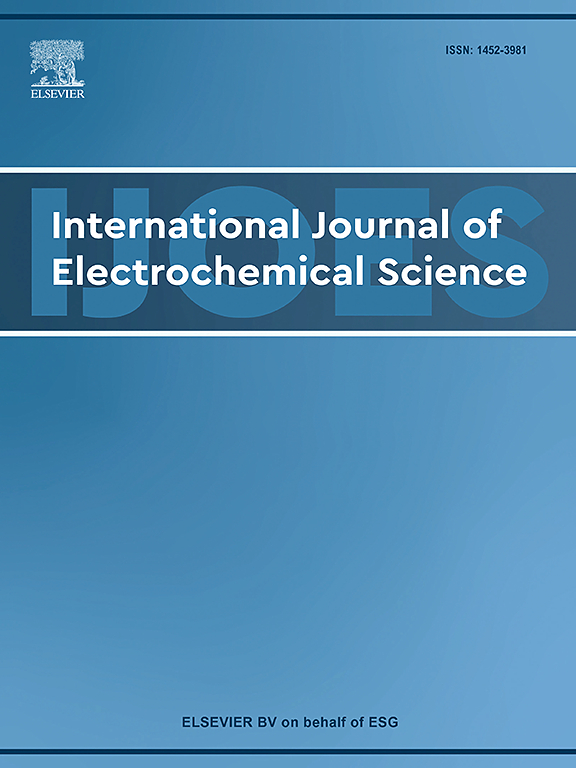Psidium guajava L. extract as corrosion inhibitor for mild steel in an acidic environment: Experimental and computational insights
IF 1.3
4区 化学
Q4 ELECTROCHEMISTRY
International Journal of Electrochemical Science
Pub Date : 2025-04-14
DOI:10.1016/j.ijoes.2025.101031
引用次数: 0
Abstract
The current research investigates the inhibitory effect of Psidium guajava leaf extract (PGLE) on mild steel (MS) in acidic solution, thus ameliorating the high demand for development of sustainable corrosion inhibitors. Herein, Psidium guajava leaf extract was considered for this research owing to its inherent chemical compositions such as flavonoids, tannins and vitamins which are responsible for its antioxidants and antimicrobial activity. The methodologies used in this work integrates detailed experimental validation based on gravimetric, combined electrochemical approach alongside computational studies. The gravimetric result demonstrated that the inhibition efficiency of the extract increased with its concentration, reaching a value of 89.4 % at 0.9 g/L and 303 K which further corroborates with impedance data. However, the inhibition efficiency decreased with an increase in temperature, highlighting the thermal degradation of the extract's active constituents at elevated temperatures which led to poor surface coverage by the extract. The adsorption of Psidium guajava leaf extract on the mild steel surface was evaluated using three adsorption models. Evidently, the best adsorption model fit was obtained via the Langmuir isotherm model. This type of model entails the formation of a barrier film layer over the mild steel thereby impeding the permeation of corrosive moieties reaching the metal surface. The morphological analysis based on SEM confirmed the formation of a protective organic film on the mild steel surface. In addition, the computational studies based on Density Functional Theory (DFT) and molecular dynamics simulation (MD) unveil the active sites and adsorption orientation of the inhibitor. As evidenced from the MD studies, the Psidium guajava leaf extract exhibited a flat adsorption coordination over the mild steel surface, thus corroborating with the experimental findings. Thus, this study provides invaluable insights into the emergence of inhibitors derived from renewable sources and shed more light on the Psidium guajava leaf extract potentials, while helping to ameliorate agricultural derived waste management problems.
番石榴提取物在酸性环境中作为低碳钢的缓蚀剂:实验和计算的见解
研究番石榴叶提取物(PGLE)在酸性溶液中对低碳钢(MS)的抑制作用,从而改善对可持续缓蚀剂开发的高要求。在本研究中,番石榴叶提取物被考虑用于本研究,因为其固有的化学成分,如黄酮类化合物,单宁和维生素,负责其抗氧化和抗菌活性。在这项工作中使用的方法集成了基于重力法的详细实验验证,结合电化学方法和计算研究。重量分析结果表明,在0.9 g/L和303 K条件下,提取物的抑制率随浓度的增加而增加,达到89.4% %,这与阻抗数据进一步吻合。然而,抑制效率随着温度的升高而下降,这突出了提取物的有效成分在高温下的热降解,导致提取物的表面覆盖率较差。采用三种吸附模型对番石榴叶提取物在低碳钢表面的吸附性能进行了评价。Langmuir等温线吸附模型拟合效果最好。这种类型的模型需要在低碳钢上形成屏障膜层,从而阻止腐蚀性部分渗透到金属表面。基于扫描电镜的形貌分析证实在低碳钢表面形成了一层有机保护膜。此外,基于密度泛函理论(DFT)和分子动力学模拟(MD)的计算研究揭示了抑制剂的活性位点和吸附取向。从MD研究中可以看出,番石榴叶提取物在低碳钢表面表现出平坦的吸附配位,从而与实验结果相吻合。因此,本研究为可再生资源抑制剂的出现提供了宝贵的见解,并进一步阐明了番石榴叶提取物的潜力,同时有助于改善农业衍生废物管理问题。
本文章由计算机程序翻译,如有差异,请以英文原文为准。
求助全文
约1分钟内获得全文
求助全文
来源期刊
CiteScore
3.00
自引率
20.00%
发文量
714
审稿时长
2.6 months
期刊介绍:
International Journal of Electrochemical Science is a peer-reviewed, open access journal that publishes original research articles, short communications as well as review articles in all areas of electrochemistry: Scope - Theoretical and Computational Electrochemistry - Processes on Electrodes - Electroanalytical Chemistry and Sensor Science - Corrosion - Electrochemical Energy Conversion and Storage - Electrochemical Engineering - Coatings - Electrochemical Synthesis - Bioelectrochemistry - Molecular Electrochemistry

 求助内容:
求助内容: 应助结果提醒方式:
应助结果提醒方式:


